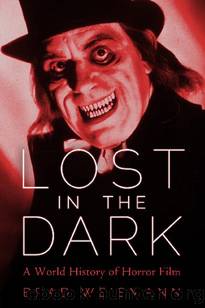Lost in the Dark by Brad Weismann

Author:Brad Weismann [Weismann, Brad]
Language: eng
Format: epub
Publisher: University Press of Mississippi
Published: 2021-04-22T00:00:00+00:00
Figures from Spainâs repressive past return to attack the living in Tombs of the Blind Dead (1972).
For inspiration, he reached back into the fabulous tales of gloomy nineteenth-century Spanish literary success Gustavo Aldolfo Becquer. Becquerâs 1861 story âEl monte de las animasâ describes a convocation of dead and cursed Knights Templar from the time of the Crusades, who were accused of heresy and slaughtered to a man by the order of the pope on Friday the 13th of October, 1307. In the story, they rise from the grave, pursuing bloody vengeance against some hapless would-be lovers.
Ossorio reset the story in the present day, and put transgressive youth in danger, prefiguring the American slasher movies of the 1980s. Here, the wandering young hipsters confront the reanimated mummies of the Knights Templar, a blood-drinking, virgin-sacrificing sect of warrior monks (we get a flashback scene of the virgin-torturing, of course). Ossorio was very firm about the Blind Dead (so-called because their exhibited corpses had their eyes pecked out) being mummies, not zombies, but their lust for human flesh allies them closely with Romeroâs Living Dead.
Above all, Ossorio knew how to shoot his monsters evocatively. The Blind Dead rise and gather in slow-motion, seemingly evadable but ultimately inescapable, marching together or riding on ghostly horses, swords brandished. Shot from low angles, they seem punishingâreactionary figures from the Spanish Inquisition, ready to devour the beliefless living. Tombs of the Blind Dead does not end on an optimistic note, as the hapless heroine leads the threat out into the world at large.
Blind Dead was so popular that it triggered three increasingly unbelievable sequels, including one with the threatening of glamorous models on a cruise ship (The Ghost Galleon, 1974) and a seaside romp (Night of the Seagulls, 1975). Ossorio did additional excellent work on horror projects all completed in short orderâThe Loreleyâs Grasp, Night of the Sorcerers (voodoo! beheadings! interpretive dance!), and Demon Witch Child, another Exorcist knockoff. Ossorio wrapped up his filmmaking career soon after, and wound up making a living painting and selling portraits of his Blind Dead creations.
Given their low budgets, horrible lighting, strange color values that rapidly decayed, scratchy and fragmentary prints, and jumbled storylines, many Spanish horror movies are technical horrors themselves. Bizarre effects, random bursts of sex and gore, and tedious subplots all blend and blur together in them.
Nowhere is this look more present than in the films of Paul Naschy, aka Jacinto Molina Alvarez, a legend known (primarily in Spain) as the âking of Spanish horrorâ and âthe Spanish Lon Chaney.â Inspired by his childhood viewing of Hollywoodâs Frankenstein Meets the Wolf Man, the short but powerfully built professional weightlifter yearned to be a horror starânot just a horror star, but the greatest and most versatile of them all. He wound up as one of the most prolific. Over the course of almost 100 horror films, he surpassed Lon Chaney Sr. in the number of horror characters played. He rivaled the stony pathos of Lon Chaney Jr. as the werewolf Waldemar Daninsky.
Download
This site does not store any files on its server. We only index and link to content provided by other sites. Please contact the content providers to delete copyright contents if any and email us, we'll remove relevant links or contents immediately.
Naked as Nature Intended by Pamela Green(415)
The Filmmaker's Guide to Creatively Embracing Limitations: Not Getting What You Want Leading to Creating What You Need (for True Epub) by Pace William & Stobbe Ingrid(412)
30 Movies to Get You Through the Holidays by Roger Ebert(387)
Bond, James Bond by Brad Gilmore(351)
It's Only a Movie! by Haberski Jr. Raymond J(318)
Chinese films in focus II by Unknown(279)
How To Write A Novel The Easy Way Using The Pulp Fiction Method To Write Better Novels: Writing Skills by Jim Driver(266)
The Fellowship of the Knits: Lord of the Rings: The Unofficial Knitting Book by Tanis Gray(264)
Smartphone Cinema: Making Great Films with Your Mobile Phone by Bart Weiss(264)
Film Truth; November, 1920 by Anonymous(259)
Charles McGraw by Alan K. Rode(254)
The Greatest Show on Earth by Jerry Pinto(252)
Thomas Mann and Friedrich Nietzsche: Eroticism, Death, Music, and Laughter by Caroline Joan Picart(230)
Jafar Panahi: Interviews by Unknown(229)
The Garden in the Machine by Unknown(229)
The Reel Truth by Reed Martin(229)
Jurassic Park and Philosophy by Watkins Jessica Michaud Nicolas(224)
The Japanese Cinema Book by Hideaki Fujiki & Alastair Phillips(219)
Euro-Visions: Europe in Contemporary Cinema by Mariana Liz(215)
